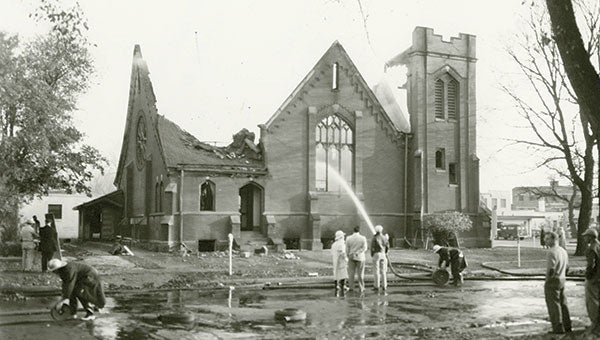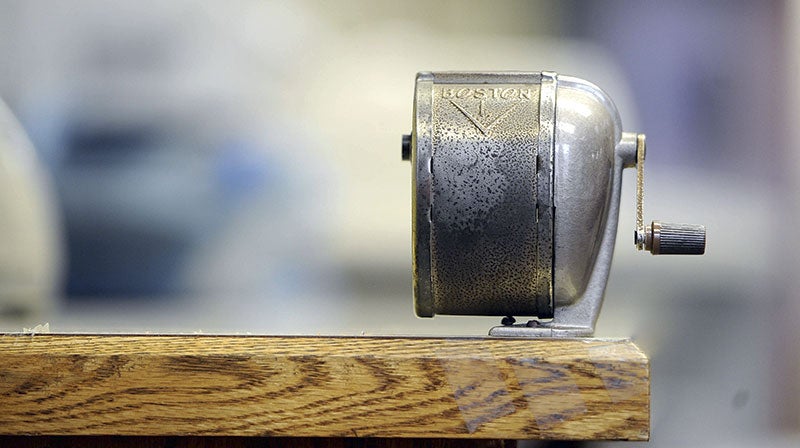Full Circle: ‘The church is on fire!’
Published 9:27 am Friday, September 4, 2015

Firefighters respond to the old Central Presbyterian Church fire.
Photo provided by the Mower County Historical Society
The shrill clangor of a persistent telephone startled me from my sleep. I awakened to pitch darkness, a rare happening, for in my 13 years I had never been awakened by a phone in the middle of the night. Nobody ever EVER called us at that godforsaken hour. This had to be serious. Downstairs I could hear the shuffling of my father’s feet as he rushed to answer.
“Hello.” Then a long pause as he listened. “I’ll be right there!” The shuffling grew louder as he hastily dressed and dashed out the door. I could hear the engine of our station wagon start up, back down the driveway and then diminish as it disappeared into the distance.
By now my three siblings and I were wide awake and on our way downstairs. “Mom, what just happened?” we all asked at once. Then looking at us with a very solemn face, she replied, “The church is on fire!”
It probably wasn’t the best of times to think of this, but it did cross my mind that our church, which I always saw as old ashen gray, was now really and truly old ashen gray, as in real old ashen gray ashes! How weird was that?
Some years before Reverend Reginald Coleman had been replaced by Reverend Lyndon Schendel. This was not exactly planned, but happened rather suddenly when Rev. Coleman closed an evening worship service with a prayer, said “amen” and dropped over dead. Right there at the pulpit! I figured if a person had to die then this was pretty good timing for after the long and fervent doxology he had just invoked, Rev. Coleman already had God’s ear. Nonetheless, it certainly must have been a rushed welcome for God, even though with his inside track on such things he already knew Rev. Coleman was on the way.
The night the church burned to a brick and ash heap Rev. Schendel was up north fishing. In his absence, he had left my father, the head deacon, in charge. Boy! Talk about bad timing. Like everything really goes wrong when you’re the back-up guy!
The truth about the church is that for some time there had been a heated debate amongst the Presbyterians over the pipe organ and its current affliction. To be sure, the instrument was awesome to behold. Its shiny burnished pipes covered the entire front of the sanctuary in a cascade from left to right of small to medium to large pipes in the center, then flowing back down to medium and small. It was an imposing in-your-face kind of organ, a thing the parishioners held in high esteem. Yes, indeed, something they could frequently boast about whenever the occasion arose (and they made sure it arose regularly), by comparing it to lesser church organs in the immediate area. (No need to name names. Those churches knew who they were!)
You see, in those days, Austin had a solid avenue of churches … Church Row, if you will. And on that spiritual pathway it was generally agreed the Presbyterian pipes were especially gorgeous, even the jealous Episcopalians attesting to the fact. You see, not many congregations could boast such a grand display across the front of their sanctuaries. Why, at first glimpse, that lineup of flashy tubes could suck the breath right out of you. And the smug Presbyterians knew it.
But, all was not well with the Presbyterians and their pipes. For all their grandeur, the pipes had a serious affliction. One of their notes stuck. It was a treble note which began playing the moment the organist flipped on the organ switch. This was problematic because it caused a discordant peal when a song was played, especially so when the music was not written in a complimentary key. But the biggest problem was the major distraction the incessant monotonic note caused during times of prayer, for the minister’s voice would then be accompanied by a background G-sharp drone, throwing the parishioners’ concentrated reverence to the celestial winds.
It wasn’t as if the note varied even slightly in pitch or volume. Instead it doggedly remained the same, like an obstinate musical fingernail scratched across a heavenly blackboard, if you know what I mean? It was the kind of agitation that could drive even the most devout person to slug down all the communion wine before it had a chance to be served … or consider joining the Congregationalists down the street. Something had to be done.
The bald truth was the church was old. With every observing turn of the head age was evident, like an old comfy shoe now covered with cracks and worn down heels. Repairs were needed throughout the entire structure, to say nothing of the immense expense of taming that infuriating G-sharp whine.
And if both of these negatives did not reflect enough in the Presbyterian’s modest collection plate coffers, the organist — who had to be blithely ambidextrous in order to play all those keys, foot pedals and what have you — was wearing out as the trial of the organ was speedily advancing her into an early old age. In other words, she was getting slow, losing the ability to turn the organ off at the precise moment the musical interlude ended and the spoken gospel began. Sometimes she didn’t make it and “Our Father Who Art in Heaven” was accompanied by the vexing musical fingernail. Even the patience of the most forbearing Presbyterian was growing thin.
Two camps existed within the congregation: the Keep-the-Organ-Camp and the Can-the-Organ-and-Build-a-New-Church-Camp. And then the fire. One had to ask if, perchance, it could have been a divine intervention?
To be sure, there was much speculation as to how the fire started. One opinion was the church had been struck by lightening that night during a violent thunderstorm. I had a different opinion. It just so happened that on that very evening there had been an event at the church. My sister Mary (15) and I (13) had been called upon to babysit, something we frequently did. The nursery was a small room located at the far distant back corner of the basement, quite possibly the most dangerous spot in the entire structure if a person had to make a fast exit from the building.
I can recall that evening looking up at the nursery ceiling and seeing the network of exposed electrical wires cross-hatching the ceiling like a thick clunky cobweb. Not only were they visibly dusty, but they were also covered in fabric, fabric so old it was frayed and unraveling. Everything about the room pleaded for a safety check, one which was guaranteed to fail.
That evening Mary and I had a large group of infants and toddlers to care for. Everything proceeded with no trouble, concluding with the parents retrieving their children. Mary and I went home. The church burned down several hours later. It was discovered that the fire started in that room! One thing was clear, it shattered the imagination to think how great the disaster could have been had the service still been in session when the fire began. It would have been utterly impossible for us two girls to have carried all the children across the expanse of that large basement and up the stairs to safety. It also begged the question if especially protective Presbyterian angels had been on duty that evening watching over us and the children? I’m thinking so.
Immediately a building committee was formed — for where would a Presbyterian Church be without a committee? Property was purchased and designs began to pile high on Rev. Schendel’s borrowed desk. My father, Gene McLaughlin, had a big hand in this. One thing he was adamant about was that the church must be built with no steps. After all, let’s face it, climbing ten steps up didn’t really bring us all that much closer to God now, did it? Why not make a building all on one level where the handicapped and the old could enter and maneuver throughout with no difficulties? It made all the sense in the world, an idea whose time had come for Austin.
And that’s what they did. The first service in the new, renamed Westminster Presbyterian Church was packed, the entire back of the sanctuary filled with wheelchairs. Folks who had never before been able to attend church on their own now could. I remember the look of satisfaction and joy on my father’s face upon seeing them there grouped together. I would have been hard pressed to say who was beaming more broadly, him or them?
In all the gloriousness of the new building, three things were missing: not a single organ pipe could be seen, no gray was in evidence anywhere and the sound of the overweening screak of a G-sharp monotone was silenced. Peace had been restored.
Peggy Keener of Austin is the author of “Potato In A Rice Bowl,” which outlines her experiences living in Japan in the 1960s while her husband was in the military. Peggy Keener invites readers to share their memories with her by emailing pggyknr@yahoo.com. Memories shared with Keener may be shared or referenced in subsequent editions of “Full Circle.”


